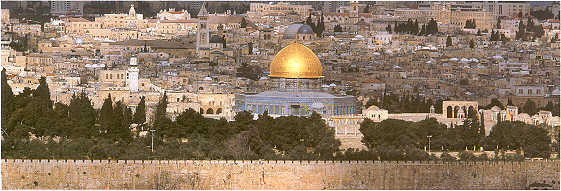
Jerusalem
Jerusalem is a small town, with many faces and weighted down with history .It offers an enormous amount to see, whether you are interested in ancient history , religion or contemporary politics.
Within the city, the third holiest site for Muslims, the Haram al-Sharif from where Prophet Mohammed rose to heaven is found; as are the Christian holy sites of Jesus' youth, crucifixion, burial and resurrection.
Gates and Walls of the Old City
The magnificent walls of Jerusalem's Old City constitute a living example of
Arab Islamic architecture. The walls surrounding the Old City were built during
the Ottoman period under the direct supervision of Sultan Suleiman AI Qanouni
in 1542. The walls stretch for twelve miles over an area of two square miles
and rise to a height of 40 feet. They contain 43 surveillance towers and 11
gates, seven of which are presently open.
1-
Damascus Gate (Bab al-Amud)
This is the largest, most elaborate and most heavily defended of the Old City's
seven gates. It is also the only one to have been excavated.
2-
Jaffa Gate (Bab al-Khalil)
Jaffa Gate is the main western entrance to the Old City .Bab al-Khalil is very
much a tourist gate. The shops around the gate are purely for tourists. On the
right just inside the gate, is one of the city's best known sites, the Citadel
or Tower of David.
3-
Zion Gate
This connects the Armenian Quarter with Mt. Zion, which lies outside the walls
and serves as a border between it and the Jewish Quarter.
4-
Dung Gate (Bab Harat al-Magharbeh)
It is the only city gate that leads to the Jewish Quarter as well as the al-Haram
al-Sharif. On the right just inside the gate, the Ophel Archaeological Gardens
capture the whole of Jerusalem's turbulent history .
5-
New Gate ( Bab al-Jadid)
Bab al-Jadid lies at the northwest corner of the Old City .It was constructed
to create access between the Christian Quarter within the city walls and the
new Christian properties outside them
6- Lions Gate (St. Stephen's Gate -Bab Isbat)
This marl<s the beginning of the Via Dolorosa and is on the eastern side
of the Old City.
7- Golden Gate
This gate has been sealed since the 1600's and legend has it that the Messiah
will pass through this gate.
The Citadel (Tower Of David)
The Tower of David is actually the minaret of a mosque built in the Ottoman
period encompassing a couple of towers, walls, ramps and gardens adjacent to
Jaffa Gate. The site is worth taking time to explore.
AI Haram al-Sharif
The site is the home of two major Islamic Shrines, EI-Aqsa Mosque and the
Dome of the Rock. The site marks the spot where The Prophet Mohammed flew from
Mecca to Jerusalem on a journey the Koran describes as the furthest -thus the
word EI-Aqsa. He then ascended to heaven leaving his footprint in a stone within
the Dome, which can be seen today. The Haram is considered to be the third most
holy site for Muslims, after Mecca arid Medina.

Western Wall
The Western Wall (called in Islamic tradition Hait el-Buraq) or the Wailing
Wall, because Jews come here to bemoan the destruction of their Temple. The
plaza in front of the wall, the Magharebah quarter, was demolished in 1967 and
turned into a synagogue.
Via Dolorosa
The Via Dolorosa (Path of Sorrow) is the traditional route Jesus followed from
his condemnation by the Romans to the spot where he was buried after the crucifixion.
The path begins near St. Stephen's Gate, in the Muslim Quarter, and ends within
the Church of the Holy Sepulchre, in the heart of the Christian Quarter. The
route is marked by the 14 Stations of the cross.
The Church of the Holy Sepulchre
The Church Of The Holy Sepulchre is the world's holiest site for Catholic and
Orthodox Christians as it preserves the most holy memories about the Death and
Resurrection of Jesus Christ. Six denominations are situated inside the Church
(Greek Orthodox,Roman Catholic, Armenian Orthodox, Coptic, Ethiopian and Syrian
Orthodox) all share control of the building.
Mount of Olives
The Mount of Olives rises some 100m to the east of the Old City across the
Kidron Valley. Green, fertile and nowadays dotted with more churches and shrines
than olive trees. Its summit affords a magnificent view of the whole of Jerusalem,
including the sealed Golden Gate of the Old City and in the other direction,
the Judean Desert, the Jordan Valley and the mountains of Moab. The Mount of
Olives is mentioned as a place where Jesus used to walk over the hill from Bethany
to Jerusalem.
Tomb of Virgin Mary
The Tomb lies at the bottom of the Mount of Olives at the right of the path.
This is considered to be the site where The Virgin Mary was entombed. The church
was rebuilt in 1130 and since then it has been shared by the Greeks, Armenians,
Syrians, Copts and Muslims. The site is venerated by Muslims since, on his night
journey from Medina to Jerusalem, The Prophet Mohammed is said to have spotted
a light over Mary's Tomb.
Gardens of the Gethsemane
Around the Church of All Nations lie the Gardens of the Gethsemane where
tradition says that Jesus prayed the night before he was arrested. The garden
is said to be 2000 years old and within it lie some of the worlds oldest olive
trees as well as a marvelous variety of flowers.
The Church of All Nations
The Church of All Nations (also known as the Basilica of Agony) is so named
because its construction in 1924 was financed by twelve different countries.
The church is built over two other churches, the Egenia dating from around 380
A.D., and a Crusader basilica of around 1170 AD The Church is also noted for
its Byzantine mosaic floor and the striking mosaic arches above the entrance.